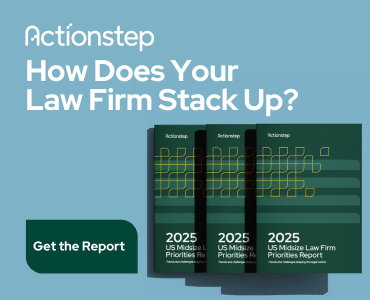For law firms, using artificial intelligence isn’t just about keeping pace with legal technology. It’s about increasing the client value proposition. These three examples show how you can incorporate AI into your workflow and compete for the high-value work clients want their lawyers to do.

Table of contents
Client Sentiment Around Law Firm AI Use Is Changing Quickly
Conversations are shifting from total prohibition of AI use to eager inquiries about AI-enhanced efficiencies. A recent Norton Rose Fulbright Litigation Trends Survey shows 73% of respondents support generative AI use by outside counsel to assist their company’s litigation work — a twofold increase over the 36% that indicated support in 2023.
It’s no secret that in-house counsel are looking to reduce spending. The same survey showed that cost efficiencies are the most popular reason for client AI support, at 45%, though respondents also pointed to time savings (32%) and scalability in workflow (27%) as key benefits. Obviously, scaled workflows and reduced timeframes lead to cost savings. But the application of AI to achieve these goals delivers ancillary benefits to clients and law firms beyond reduced spending.
It’s wise, then, to ask how you and your law firm can incorporate AI into your workflows. In a competitive market, a proactive approach to AI can resonate with your target clients if you can successfully convey the impact and value it delivers to them.
Let’s explore how your law firm can leverage AI to the best advantage and frame your use of AI as a benefit to clients.
We Know What’s in It for Clients, But What About Us?
Owing to the cost savings alone, adopting some form of AI should please your clients. But higher-value applications can benefit both the client and the law firm.
Robert Couture, a senior research fellow at the Center on the Legal Profession at Harvard Law School, conducted qualitative interviews with chief operating officers and partners responsible for AI deployment from 10 Am Law 100 firms. He quoted one law firm leader as saying:
AI may cause the ‘80/20 inversion’; 80% of time was spent collecting information, and 20% was strategic analysis and implications. We’re trying to flip those timeframes.
Couture writes that 90% of firms interviewed believed that additional time freed up by the use of GenAI will likely improve outside counsel’s “quality of service,” in addition to decreasing expenses overall.
Three Ways AI Increases Value
Here are three examples of ways lawyers can utilize AI to spend less time mired in data and direct that energy toward higher-value tasks.
1. Risk Management: Develop Case Strategy Faster With AI
Because of the lengthy cycles involved in litigation, all parties are trying to speed up the assessment process to their advantage. Streamlining early case assessment with AI can not only help corporations better manage risk but may also uncover critical facts, giving lawyers a leg up in developing a winning legal case strategy.
Corporate counsel are already using AI to review their company data for risk management purposes. For example, AI can review on-premises accidents to analyze a likely settlement or verdict range compared to similar cases, giving counsel valuable insight as to whether the company should consider an early settlement offer to reduce overall litigation cost. If corporations can do this internally, they expect outside counsel to deliver higher-value insights quickly. AI can help.
Let’s say a company runs its early case assessment and, instead of making an early settlement offer, it chooses to engage outside counsel and pursue litigation. Your law firm is now on the clock to identify the risks to the client and develop a case strategy. Your team must comb through the matter file and complaint to identify the parties, their claims and the timelines.
AI can automate the review process, help lawyers find, query and link key information to witnesses and events. AI can even identify events and build an initial case chronology. Once the automated review is complete, lawyers will verify the information and, using the AI-generated insights, highlight inconsistencies and crucial questions to ask in a deposition or pursue as a core case strategy.
Throughout the process, lawyers draw on their deep experience and legal expertise to discern and apply only the most pertinent facts and arguments, crafting strategies to drive cases toward resolution. An AI-savvy client may not accept a bill for all the human time it would take to review and organize reams of information. But they would pay for faster insights and accurate risk assessment, resulting in strategies that further the client’s litigation goals. In this context, AI-assisted legal analysis still demands legal acumen and qualifies as billable legal work.
2. Time Savings: GenAI Fills the Billing Gap
While law firms can raise their billing rates or bill more hours, growth will not happen if realization rates drop. Clients will push back on paying for hours spent “idling” — such as combing through previously reviewed documents to find the source of a recalled but uncited fact or bringing new associates up to speed. What they do value is forward motion: when the case is moving closer to resolution through a winning trial strategy, a settlement or motion practice.
Of course, just as lawyers need to review case materials to build a strategy, the necessary nonbillable work must also be completed. That’s where AI helps bridge the gap between the work that must be done and the work clients are willing to pay for.
For example, manually reviewing a lengthy transcript can take hours. With the AI built into modern case management software, your team can identify key discrepancies in a transcript in minutes. Your team can then use the available time to validate and apply those key discrepancies to strengthen your case strategy. Instead of billing time for document review, you can spend your time focused on higher-value work and more effectively advance client goals.
3. Scaled Workflows: Use AI to Retain Knowledge
Litigation teams can leverage scaled workflows to their advantage. For instance, following a deposition, an attorney may write a summary of the event, including topics discussed, insights and effect on strategy. But creating summaries from memory or partial notes is less thorough than a complete summary of the deposition transcript.
Instead, you can use AI to generate a thorough deposition summary and then validate and personalize the automated summary with the human commentary and analysis AI can’t provide, such as calling out observations of deponent body language and tone. The resulting work product is comprehensive and delivers high-level insight to the client.
A deposition summary of this kind also serves as a reliable touchpoint for future reference, or to bring new attorneys up to speed without spending hours on nonbillable secondary review. With a trustworthy and comprehensive summary, the knowledge gained from a deposition can be shared with the entire legal team. More importantly, the value of the testimony is preserved beyond the recollection of the attorney who attended the deposition.
This type of scaled workflow can be used at all stages of litigation, from initial reviews to research and writing. The key is to supervise the applied AI and create a trustworthy work product that eliminates future wasted time. Instead, scaled workflows should add value by eliminating knowledge gaps, avoiding nonbillable work, and creating time for true legal analysis.
How Do We Talk to Clients About Using AI?
It’s crucial to define and convey to clients how and when the firm uses AI. Not only does the duty of communication to the client demand it, but firm or corporate policies and retention agreements may also require disclosure.
As a starting point, lawyers should clarify that the use of AI is not a replacement for their responsibilities as counsel, nor for their knowledge and experience. Rather, by framing AI as a way of enhancing legal work, you signal to clients that you are invested in creating efficiencies that lead to faster and better outcomes. Essentially, AI can speed up the way lawyers review and understand materials and reach the analysis phase, where a lawyer’s insight and experience determine relevance, weigh the risks, and build a strategy tailored to client goals.
AI cannot replace a lawyer’s insight or skill set, but it can help get to the point more efficiently and comprehensively, which your clients now expect and will appreciate.
Why the AI Client Value Proposition Matters
For law firms, incorporating AI into workflows is not just about keeping pace with technology. It’s about enhancing your client value proposition. By embracing AI, firms can scale workflows to prioritize strategic analysis and high-value legal work. This shift not only aligns with clients’ desires for cost savings, but it also allows firms to fill the billing gap, better manage risks and retain critical knowledge.
By proactively adopting AI as an enhancement rather than a replacement for human expertise, your law firm can earn clients’ trust and increase the value of your services.
Image © iStockPhoto.com.

Sign up for Attorney at Work’s daily practice tips newsletter here and subscribe to our podcast, Attorney at Work Today.















